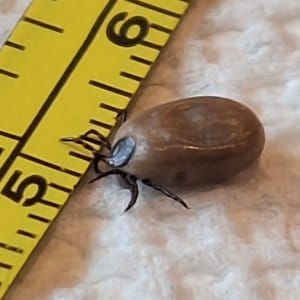Can Ticks Invade Canada Faster?
Some North American tick species seem to be expanding northward more quickly than their physiological cold tolerance allows. A new paper proposes an explanation.

May, filled as it is with spring weather and tempting hiking trails, often has a lot of articles about ticks...and, of course, of a lot of actual ticks.
So, here's one more. Article, that is.
As the world warms, species shift their "ranges" so they can continue to live in conditions where they are most successful.2 How and why ticks make these shifts are the subjects of a lot of study.

Ticks by themselves don't migrate far (such short little legs), but they do ride around on animals who have a lot of mobility. As the animals go from region to region, ticks survive or die, depending on temperature, humidity, land features, human responses, food availability, and many other conditions, subtle or obvious.
Individual ticks can modify their behaviours and activities to survive (this little trick is called phenotypic plasticity): for instance, they can seek different types of shelter in new biomes to survive extreme temperatures6. But, over longer periods of time, tick species can also evolve to become better-adapted to particular temperatures. The dynamics are much more complex than just simple migration.
This paper proposes—and tests—a novel mechanism that might enable this too-rapid rapid spread.
Quite aside from everything else, the paper is a beautiful example of how science leads us to unexpected conclusions. Here's the story.
The researchers started with a prediction: "that sublethal pesticide exposure would make ticks more sensitive to extreme temperatures." In other words, they thought that ticks who were exposed to pesticide but did not die would be more sensitive to cold, and would be less hardy. The researchers thought "damaged" ticks would die more easily in cold weather.
So, as any good scientist would, they designed an experiment. They planned to gather live specimens from two tick species. They would find out what temperature killed half a group of "normal" ticks in a standard time period. This is called the LT50 (Lethal Temperature 50%). Then they would expose ticks to "sub-lethal" doses of two common residential and agricultural pesticides, and, finally, expose them to cold to measure the LT50 again. Tough day at the office if you're a tick, that's for sure.
The experiment started predictably. Half the control populations of D. variabilis (commonly called the "dog tick" or "wood tick") died at a temperature of -16°C. Following their plan, the researchers then exposed populations of the same species to near-fatal doses of pesticides. After what we imagine was a wee break, they cold-exposed the tick populations again.
And then...
The LT50 shifted to -19°C. Yep, that's right. After pesticide exposure, the ticks got tougher...more resistant to temperature.
So the researchers did a detailed analysis of some previous RNA-sequence data from D. variabilis cells, and, in their own words:
When exposed to pesticides, ticks are genetically disposed to become more tolerant of cold.
Which immediately causes us to yell out an obvious question: Does this mean that ticks exposed to pesticide will invade Canada faster?
The researchers had more-or-less the same question, so they developed a "novel approach" that allowed them to incorporate physiological survival data into species distribution models. And yes, the models predict that pesticide-exposed D. variabilis individuals may be able to invade Canada more quickly.
Tiny parasitic arachnids. Big results.
Science works!
This is such a great example of how science works. Begin with a hypothesis, design a test to validate it, discover you had it wrong, make a new hypothesis, do more testing, look for a mechanism, model the implications of your discovery. Then pre-publish it all, wait for peer review, publish the final paper, and settle in to see if others can replicate your results. If the evidence converges on your hypothesis, you just might have something. If it doesn't, well ... you have more work to do. It's absolutely the most-rational way to discover facts, and it can lead you to unexpected places.
What a joy!
Reading
- Centers for Disease Control and Prevention. “Adult Female Blacklegged Tick, Ixodes scapularis, Being Removed with Fine-Tipped Tweezers.” Public Health Image Library, Image #28384. Accessed May 14, 2025. https://phil.cdc.gov/Details.aspx?pid=28384.
- Eriksson, Britas Klemens, and Helmut Hillebrand. “Rapid Reorganization of Global Biodiversity.” Science 366, no. 6463 (October 18, 2019): 308–9. https://doi.org/10.1126/science.aaz4520.
- eTick.ca. "Ixodes scapularis observed in Bonnyville, Alberta, ID: 6C7E27AC-5DCC-AD35-7D7D-E24A41D7DA50.jpg." Accessed May 14, 2025. https://www.etick.ca/attachments/observations/square/6C7E27AC-5DCC-AD35-7D7D-E24A41D7DA50.jpg.
- Elmieh, Negar, and National Collaborating Centre for Environmental Health. “The Impacts of Climate and Land Use Change on Tick-Related Risks.” Evidence Reviews, November, 2022. Accessed May 14, 2025. https://ncceh.ca/resources/evidence-reviews/impacts-climate-and-land-use-change-tick-related-risks
- Ogden, Nicholas H., C. Ben Beard, Howard S. Ginsberg, and Jean I. Tsao. “Possible Effects of Climate Change on Ixodid Ticks and the Pathogens They Transmit: Predictions and Observations.” Journal of Medical Entomology 58, no. 4 (July 16, 2021): 1536–45. https://doi.org/10.1093/jme/tjaa220.
- Gilbert, Lucy. “The Impacts of Climate Change on Ticks and Tick-Borne Disease Risk.” Annual Review of Entomology 66, no. 1 (January 7, 2021): 373–88. https://doi.org/10.1146/annurev-ento-052720-094533.
- Oyen, Kennan J., Thomas Arya, Benjamin Davies, Elise M. Didion, and Joshua B. Benoit. “Sub-Lethal Pesticide Exposure Facilitates the Potential Northward Range Shifts of Ticks by Increasing Cold Tolerance and Overwintering Survival.” bioRxiv, April 19, 2025. https://doi.org/10.1101/2025.04.14.648794.
